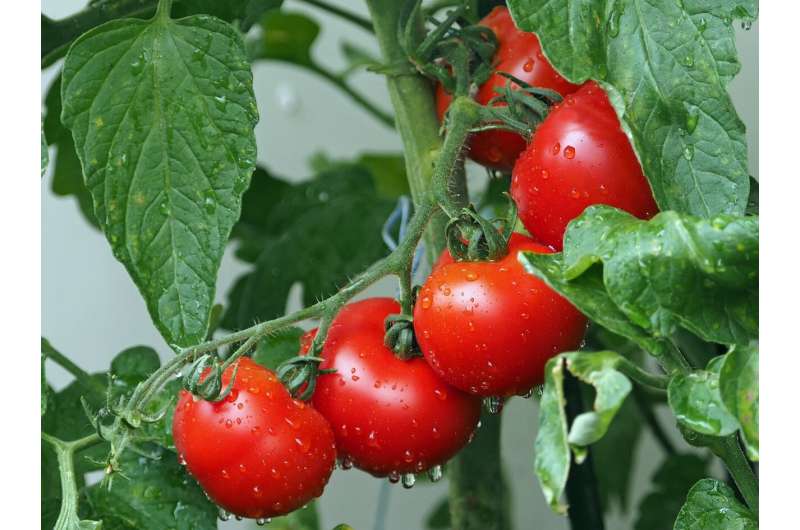This article has been reviewed according to Science X's editorial process and policies. Editors have highlighted the following attributes while ensuring the content's credibility:
fact-checked
peer-reviewed publication
trusted source
proofread
Optimal spacing determined for grafted 'Primo Red' high tunnel tomato

As the global demand for high-quality tomatoes continues to rise, researchers have unveiled findings on the optimal spacing of grafted "Primo Red" tomatoes within high tunnel systems. The study offers important insights into enhancing yield and quality for tomato producers worldwide.
The work is published in the journal HortTechnology.
High tunnels are well suited for tomato production, and in some research, have demonstrated three times more profitability than a field-grown crop. In some geographic regions, the controlled environment allows growers to bring tomatoes to market approximately 3 to 4 weeks earlier than field-grown plants, allowing some growers to charge a premium price.
While the exclusion of precipitation allows tomato foliage to remain dry, the foliar disease is still common in high tunnel tomato production due in part to vigorous foliar growth, reduced airflow, dense plant spacing, and high humidity within the plant canopy. Intensive, year-round cultivation without rotation can also lead to the degradation of many soil health parameters as well as the buildup of soilborne disease.
Research has shown that grafting tomatoes to resistant rootstocks can help manage soilborne diseases such as Fusarium wilt [Fusarium oxysporum f.sp. Lycopersici, bacterial wilt [Ralstonia solanacearum, southern blight [Sclerotium rolfsii, and root-knot nematodes. Breeding efforts have produced many disease-resistant rootstocks that can increase plant vigor in grafted scion cultivars compared with ungrafted plants of the same cultivar, although it is not entirely clear which traits contribute to the increased vigor.
It has been hypothesized that the increased plant vigor resulting from the grafted rootstocks may be associated with plant hormone production, the size of the root system and the corresponding increased water uptake, and increased nutrient uptake or efficiency
The objectives of the new study were to determine the effect of plant spacing on yield of grafted vs. ungrafted "Primo Red" tomato plants and to explore the economics of grafting. "Maxifort" was selected as the rootstock for this study because it carries resistance genes to many common soilborne diseases in the United States. "Maxifort" also increases vegetative vigor. Given the additional vigor and foliage of "Maxifort" grafts, growers may be able to adopt a lower-density planting strategy.
Wider spacings (20 and 24 inches) generally resulted in higher yields from both ungrafted "Primo Red" and grafted "Primo Red" plants in terms of fruit number per plant and yield per plant. The researchers observed a 27% increase in yield between grafted and ungrafted tomato plants at the 16-inch spacing, a 16% increase at the 20-inch spacing, and a 17% increase at the 24-inch spacing
Despite the higher cost of production associated with grafted tomato transplants, high tunnel growers experiencing problems with soilborne diseases can benefit from the increased plant vigor and yields. Given the additional vigor of grafted plants, commercial growers may consider lower-density plantings to avoid foliar diseases and maximize yield per plant. However, yield must be considered over commercial plant spacings.
This study found that "Primo Red" grafted tomato transplants will out-yield ungrafted transplants at 16-, 20-, and 24-inch spacings. Furthermore, the additional cost of grafted transplants is offset by the higher yields, resulting in higher net revenues for grafted tomato systems at all plant spacings.
Net revenue is highest for grafted and ungrafted transplants at the 16-inch plant spacing despite the additional foliage of the grafted plants. The data also show that although not as profitable, the 20-inch spacing of grafted transplants was more profitable than all of the ungrafted transplants.
In an industry where efficiency and sustainability are paramount, the findings of this research hold great promise for tomato producers seeking to meet the demands of an ever-expanding market. By embracing innovation and science-backed practices, growers can cultivate tomatoes that not only satisfy consumer preferences but also contribute to the long-term viability of agricultural systems.
According to the authors, "This research was motivated by the hundreds of soil based greenhouses we've worked with, where tomatoes or other vegetable crops are grown repeatedly year after year. Growers reported decreasing yields, and we were able to confirm soil-based challenges such as nematodes, Fusarium, and nutrient imbalances. Grafting presented a solution to maintain yield in the face of these issues. Our cooperating farmers at Maple Lane, Nelson, and Ruth Hoover, were essential in conducting the research."
More information: Judson Reid et al, Optimal Spacing of Grafted 'Primo Red' High Tunnel Tomato, HortTechnology (2023). DOI: 10.21273/HORTTECH05188-23
Journal information: HortTechnology
Provided by American Society for Horticultural Science




















